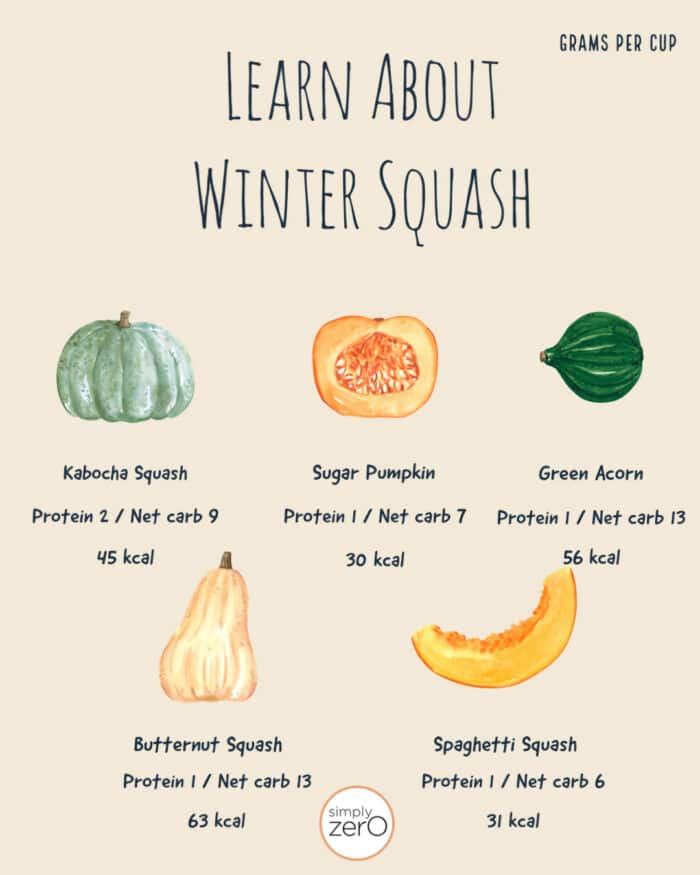
Written By: Gloria Tsang, RD
Title: Founding Registered Dietitian
Alumni: University of British Columbia
Last Updated on:

Generally split into two groups – summer and winter – squash is a group of vegetables that are fleshy on the inside and protected by a hard rind on the outside. The most common varieties are pumpkins, zucchinis, acorn squash, and butternut squash. These colorful fall favorites are loaded with wonderful nutrition: Vitamin C, Vitamin A, and dietary fiber. With many varieties offering distinct flavors, squash is an excellent addition to soups, pastas, and chilis that can help keep you warm on those cold late-autumn days.

Table of Contents
Squash has been a staple part of the North American diet since long before Europeans arrived, and it’s easy to see why. Easy to store and prepare, squash provides a simple way to add nutritious vitamins and extra fiber to every meal. Just one cup of baked winter squash provides more than 100% of the daily recommended value of Vitamin A (in the form of beta-carotene), and 25% of the daily recommended value of fiber. The beta-carotene in squash is a powerful antioxidant and has anti-inflammatory properties. That’s a lot of nutrition packed into only a food with only around 100 calories.
With a mild, nutty flavor, butternut squash is an easy addition to a variety of dishes. Steam chunks until tender, then puree with a little skim milk, a tablespoon of Greek yogurt, salt, pepper and cinnamon for a creamy side dish that squeezes in more nutrition than traditional potatoes. If you’re looking to pump up your (or your kids’) mac and cheese, just stir some of the puree into the pasta pot. Alternately, butternut squash is perfect for a warm winter salad. Try our Roasted Butternut Squash Warm Kale Salad recipe.
Nutrition facts of butternut squash (one cup, cubed):
Good news! There’s no need to worry about peeling this one. Simply cut in half crosswise and scoop out the seeds and fibers. For a sweet side, fill the hollow with a mixture of chopped pear and dried cranberries with a little cinnamon, butter, and brown sugar. For savory flavor, rub the cut flesh with olive oil and sprinkle with whatever fresh herbs you have hand (try sage and garlic for a change), then garnish with shaved parmesan just before serving. No matter whether you go sweet or savory, baking your squash in a 350 degree oven for about 45 minutes (or until it’s tender) is all you need to do.
Nutrition facts of acorn squash (one cup, cubed):
Kabocha squash is also known as buttercup squash or Japanese squash. Kobocha is by way my favorite winter squash! It’s small enough to carry home, cut without worrying breaking my knife, and sweet enough without adding any condiments. In fact, its taste profile is quite similar to sweet potatoes. Just as with acorn squash, you can prepare it simply by halving, seasoning and baking until tender. Shake up your menu and try it in recipes that call for sweet potato – like soups or stews. I also love slicing them to make squash tempura.
Nutrition facts of kabocha squash (one cup, cubed):
Spaghetti squash’s unique, stringy flesh is just like the name implies. So, add a family-friendly veggie punch to your meal by tossing a portion of spaghetti pasta with an equal portion of cooked spaghetti squash. Then, mix in some white beans and top with your usual sauce and a sprinkle of parmesan. It’s easy to cook spaghetti squash – simply pierce with a fork and bake whole at 375 degrees for an hour. If you’re in a big hurry, you can also pierce the flesh generously with a knife and pop into the microwave for 10 minutes; For both cooking methods, simply cool before cutting, then use a fork to scrape away seeds to uncover the spaghetti-like strands. Alternately, cut squash in halves, then remove seeds before putting it into the oven. Then fluff up the flesh once baked.
Nutrition facts of spaghetti squash (one cup, cubed):
Don’t forget the most popular squash of them all! Skip the big pumpkins – they’re only good for jack o’ lanterns – and and go with 2-5 pound sugar pumpkins (aka sugar pie pumpkins) meant for cooking. Despite being called “sugar pumpkins”, they are not as sweet as other squashes such as kabocha squash. Hence it’s more ideal to be used in dessert dishes or other dishes that will have sugar in the recipe. For instance, you can use pumpkin puree – whether you go fresh or canned – makes a great addition to waffle batter or whole wheat muffins. For a vegan option in baking, simply sub ¼ cup pumpkin puree where the recipe calls for eggs. ash.
Nutrition facts of pumpkin (one cup, cubed):
Alumni: University of British Columbia – Gloria Tsang is the author of 6 books and the founder of HealthCastle.com, the largest online nutrition network run by registered dietitians. Her work has appeared in major national publications, and she is a regularly featured nutrition expert for media outlets across the country. The Huffington Post named her one of its Top 20 Nutrition Experts on Twitter. Gloria’s articles have appeared on various media such as Reuters, NBC & ABC affiliates, The Chicago Sun-Times, Reader’s Digest Canada, iVillage and USA Today.
butternut squash, health benefits, healthy every month, nutrition facts, pumpkin, squash, vegetables, winter squash
Ive tried all of these except the Kabocha. Sounds yummy Will be adding this squash to my diet